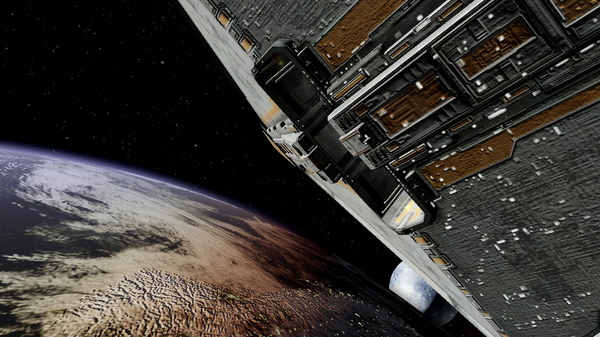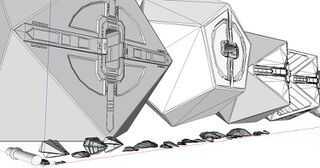Realism
Oolite is modelled on Classic Elite - a very simplistic but very playable game published in 1984. Realism is often seen as conflicting with playability.
Contents
Overview
Oolite is modelled on Classic Elite - a very simplistic but very playable game published in 1984.
Realism is often seen as conflicting with playability. More realism requires suitable oxps. More playability is often accompanied by Handwavium.
Issues with scale
If you're new to Oolite's internal workings you should know that sizes and distances are totally messed up. The two short rules of thumb are: (1) ships are very much oversized, and everything else is very much undersized; and (2) none of the sizes makes sense in relation to human size... The scales of sizes in Oolite are bent deliberately because of playability. Ships are much bigger than it would seem sensible in order to allow the player to see them (and hit them). Realistically sized ships would practically always be just single pixels on your screen. Almost impossible to see any detail, almost impossible to hit. A waste of beautiful models. Planets and distances between bodies in space, on the other hand, are much, much smaller than it would seem sensible in order to allow the player to ever interact with anybody. A realistically sized space would be so huge and empty that you would spend most of your time completely on your own on very boring journeys. Both would make for terrible gameplay. Thus the lack of realism is the price we have to pay for making Oolite a playable game in the first place. Commander McLane (2012)
Issues with Physics/Science & Economics
Classic Elite was written for early computers. David Braben's Frontier series (written a decade later for more powerful computers) tried to import more real-world physics and astronomy into gaming. But Oolite, being a copy of Classic Elite, suffered from the simplicity inherent in the early game. Thus the astronomy, the physics and the economics are all unreal simplifications which, however, combine to make a much more playable game.
As the years have gone by, there have been those pushing for a more realistic approach (originally, some who came to Oolite through Frontier), and other pushing for a more game-focused approach (perhaps those who preferred Classic Elite - Frontier had playability problems). The arguments on each side are good, and the open nature of Oolite means that there are a plethora of OXPs which modify the game in one's desired direction.
But restrictions in the coding mean that there are no black holes, no binary stars, no asteroid rings (this might be oxp-able) and no realistic solar texturing. There is no ability to fly from one solar system to another without a hyperspace jump (not even the 0ly jumps from Lazaso to Zaenza or Tetiri/Orlaed).
Issues with Equipment
There are no 3D depictions of the eight galaxies. Nor any accurate way of giving direction (when docked), just distance.
There are no depictions at all of what is in the solar systems (other than the ViewScreen views and the scanner - Telescope adds to this). Lists of distances, yes. Maps, no.
Issues with Gameplay
There is no ability to do anything inside one's ship other than pilot it (use the mediStim bay, sleep, eat, etc.). There is as yet no ability to perform an EVA. Interaction with the Orbital Stations is minimal - as is the ability to do anything different on the planet's surface (except for Feudal States). The crew for the larger ships do not exist in any meaningful manner.
Player centrism
There are also issues with player centrism.
- 1) Tweaks to the vanilla game to make it more playable: giving a speed boost to the player's ship to help it escape mass-locks; not giving shields to NPCs to compensate for their lack of breakable equipment, no Torus drive for NPCs, etc.
- 2) There are long-standing arguments about the extent to which the player ought to be able to really affect things in the game. See the System Populator Memory thread.
Realistic Solutions
Astronomy/Physics
- Strangers World deals with a large number of these: to whit, some of the issues of scale/distance, astronomy, fuel-less travel, visible laser beams etc.
- Ship Configuration OXP implements the impact of equipment volume, weight, heat production and breakability.
- The Rescaling experiment attempts to sort out some of the distance/size issues.
- Guide to Ambience OXPs details a number of OXPs addressing issues of astronomy.
- Astrobe's Inertia.oxp (2017)
- Gravitation OXP by Tch from Roolite (2013)
Combat
In Oolite when you get hit, your shields absorb the damage. When your shields are gone, the damage impacts directly on your ship, and may damage equipment or trade goods. It never destroys equipment. It never causes damage to your hull, or fuel leaks, etc. This is remedied by these oxp's:
- BattleDamage designed just to make damage more realistic (Smivs)
- CustomShields shows visually the effects of damage - including fuel leaks
- HardShips adds physical armour to the ships in the game - but also increases chances of eg fuel leaks
Player centrism
- Cheating - despite being less player-centred than the original Classic Elite, there are still a handful of areas where the game code gives players an unfair advantage over NPC's. See the collection of "anti-cheating oxp's" listed here.
Death
- Penalize Death.oxp Making death hurt (2012). By Spara.
Economics
- See Economics for a number of attempts to sort out issues with trade and markets.
Time
- Cargo Handling OXP- by Phkb (2018): Loading/unloading cargo now takes time rather than being instantaneous!
Discussions
Here on the wiki
- Newtonian modelling
- Cheating - see the anti-cheating discussion
- Handwavium - explaining away unrealistic elements
On the BB
Laws of Physics
- Oolite essay: game lore, features and mechanics Stranger's Essay for Roolite (the Russian Oolite web-site)
- Is it possible to add in Gravity/Inertia? (2017) ...with Astrobe's .oxp link
- GAME CHANGER - A little overlooked law of aerospace science. (2011) The dynamics of travel in space. Friction, cosmic ray secondary muons, Bermuda Triangle, absolute zero, achilles' heels in ship designs, Uberships...
- Artificial Gravity and Space Stations (2012)
- Calculating the mass of Oolite ships (2010]
- Selezen's take on physics - leading on to Captain Hesperus on the courses at Lave Academy (2008)
Astronomy
- Asteroids in clumps rather than in belts (2006/22).
Ships
- Ubership has links to a number of BB threads on unrealistic ships
- Dance the Balance has an analysis of ship size (ie cargo hold size) vs speed.
- Aegidian's explanation of the super-sized ships (2006)
Trade
- Commodity sub-types (2015+): note Redspear's powerful defence of the playable Oolite trade model.
- Perfectly balanced economics? (2022): szaum-ix's thread on making Oolites trade model more realistic.
Other
- A moment of existential angst (2010) - Religion, Food
- System Populator Memory (2016) - to what extent should the player's actions affect what will happen in the system?
- Enabling EVA's in Oolite (2022)
- Using the ship's mediStim Bay (2022)
- Resuscitatory Project for Life in the Frontier (2022)
- Crew
- Size of crewmember vs. size of Cobra Mk.3 "window" - there is much discussion whether these are windows or something else.
On the Other Hand...
- Superstitious Behaviour? (2018)
Elsewhere
- Misconceptions about Space Warfare (2016: Children of a Dead Earth - realistic space game)
Gameplay and Balance indicator
Sadly, making the game more realistic almost invariably involves making it tougher (often much tougher) to play!


